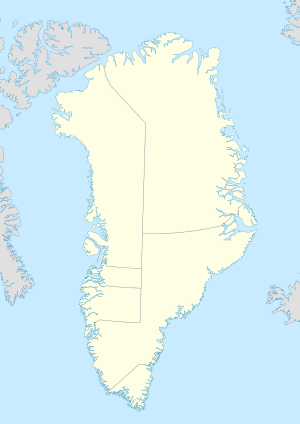Kulusuk
|
Kulusuk Kap Dan |
|
|---|---|

Kulusuk in winter
|
|
| Location within Greenland | |
| Coordinates: 65°34′31″N 37°11′00″W / 65.57528°N 37.18333°WCoordinates: 65°34′31″N 37°11′00″W / 65.57528°N 37.18333°W | |
| State |
|
| Constituent country |
|
| Municipality |
|
| Founded | 1909 |
| Government | |
| • Mayor | Pele Maratse |
| Population (2013) | |
| • Total | 267 |
| Time zone | UTC-03 |
| Postal code | 3915 |
Kulusuk (old spelling: Qulusuk), formerly Kap Dan, is a settlement in the Sermersooq municipality in southeastern Greenland, located on an island of the same name. The settlement population of 267 is quite uncommon for an Inuit settlement in Greenland with many Danes choosing to live there due to the airport. In Kalaallisut, the name of the village means "Chest of a Black Guillemot".
The urbanized area of the settlement is centered around the harbour in the northwestern part of the island, on the shores of the Torsuut Tunoq sound. Industrial utility buildings are also scattered in the vicinity of the airport, to the northwest of the runway.
The island is small, 8 km (5.0 mi) from north to south and 11 km (6.8 mi) from west to east. It is hilly throughout, with several distinct mountains dominating the eastern and southern coast. The southernmost point is Cape Naujaangivit, formerly Cape Dan (Danish: Kap Dan, a name previously extended to the settlement and island) under the Isikajia mountain.
The highest point on the island is the summit of Qalorujoorneq, at 676 m (2,217.8 ft) topping a wide mountain massif in the southeast, directly above the airport.
The Saqqaq people were the first to reach eastern Greenland, arriving from the north through what is now known as Peary Land and Independence Fjord. They were displaced by the Dorset culture around 3,000 years ago. The Thule people passed through the area in the 15th century, finding the southeastern coast uninhabited.
Due to back-migrations to the more densely populated western coast, the southeastern coast was deserted for another two hundred years. The region wasn't settled until the late 18th century, with the current town of Tasiilaq – then known as Ammassalik – surviving as the only permanent settlement in the 19th century. Population increased however from the 1880s, dispersing over several villages in the area.
...
Wikipedia

